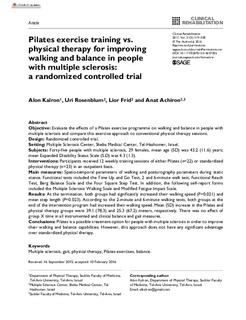| dc.contributor.author | Kalron, Alon | |
| dc.contributor.author | Rosenblum, Uri | |
| dc.contributor.author | Frid, Lior | |
| dc.contributor.author | Achiron, Anat | |
| dc.date.accessioned | 2019-02-22T12:14:37Z | |
| dc.date.available | 2019-02-22T12:14:37Z | |
| dc.date.issued | 2016 | |
| dc.identifier.citation | Kalron, A., Rosenblum, U., Frid, L., & Achiron, A. (2017). Pilates exercise training vs. physical therapy for improving walking and balance in people with multiple sclerosis: a randomized controlled trial. Clinical Rehabilitation, 31(3), 319–328. | nb_NO |
| dc.identifier.uri | http://hdl.handle.net/11250/2587038 | |
| dc.description.abstract | Objective: Evaluate the effects of a Pilates exercise programme on walking and balance in people with multiple sclerosis and compare this exercise approach to conventional physical therapy sessions.
Design: Randomized controlled trial.
Setting: Multiple Sclerosis Center, Sheba Medical Center, Tel-Hashomer, Israel.
Subjects: Forty-five people with multiple sclerosis, 29 females, mean age (SD) was 43.2 (11.6) years; mean Expanded Disability Status Scale (S.D) was 4.3 (1.3).
Interventions: Participants received 12 weekly training sessions of either Pilates (n=22) or standardized physical therapy (n=23) in an outpatient basis.
Main measures: Spatio-temporal parameters of walking and posturography parameters during static stance. Functional tests included the Time Up and Go Test, 2 and 6-minute walk test, Functional Reach Test, Berg Balance Scale and the Four Square Step Test. In addition, the following self-report forms included the Multiple Sclerosis Walking Scale and Modified Fatigue Impact Scale.
Results: At the termination, both groups had significantly increased their walking speed (P=0.021) and mean step length (P=0.023). According to the 2-minute and 6-minute walking tests, both groups at the end of the intervention program had increased their walking speed. Mean (SD) increase in the Pilates and physical therapy groups were 39.1 (78.3) and 25.3 (67.2) meters, respectively. There was no effect of group X time in all instrumented and clinical balance and gait measures.
Conclusions: Pilates is a possible treatment option for people with multiple sclerosis in order to improve their walking and balance capabilities. However, this approach does not have any significant advantage over standardized physical therapy. | nb_NO |
| dc.publisher | Clinical Rehabilitation | nb_NO |
| dc.subject | multiple sclerosis | nb_NO |
| dc.subject | Gait | nb_NO |
| dc.subject | physical therapy | nb_NO |
| dc.subject | Pilates exercises | nb_NO |
| dc.subject | balance | nb_NO |
| dc.title | Pilates exercise training vs. physical therapy for improving walking and balance in people with multiple sclerosis: a randomized controlled trial | nb_NO |
| dc.type | Journal article | nb_NO |
| dc.source.pagenumber | 319-328 | nb_NO |
| dc.source.volume | 31 | nb_NO |
| dc.source.journal | Clinical Rehabilitation | nb_NO |
| dc.source.issue | 3 | nb_NO |
| dc.identifier.doi | https://doi.org/10.1177/0269215516637202 | |
| dc.description.localcode | måsjekkes | |
